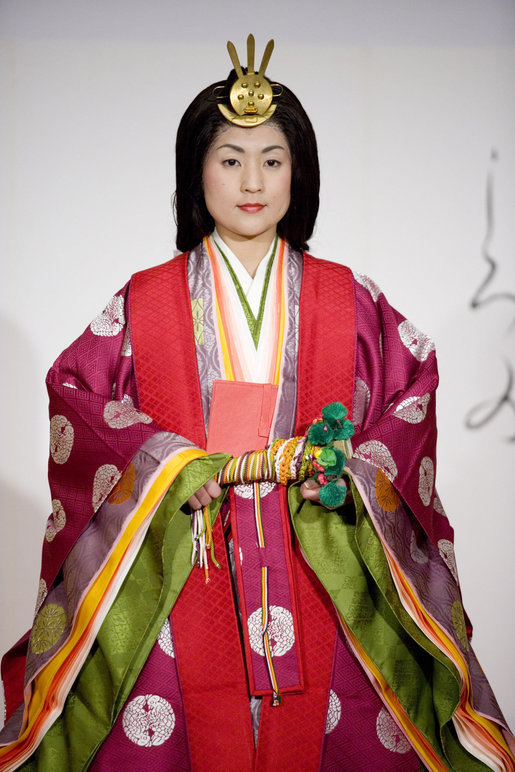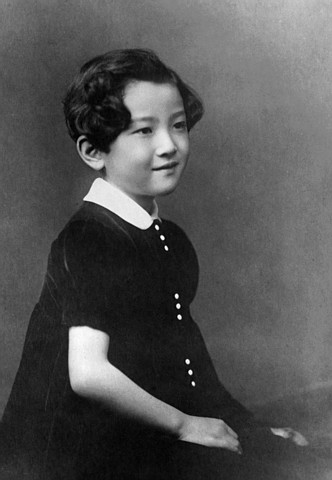|
Jūnihitoe
The , more formally known as the , is a style of formal court dress first worn in the Heian period by noble women and ladies-in-waiting at the Japanese Imperial Court. The was composed of a number of kimono-like robes, layered on top of each other, with the outer robes cut both larger and thinner to reveal the layered garments underneath. These robes were referred to as , with the innermost robe – worn as underwear against the skin – known as the . were also worn as underwear with the ; over time, the two would gradually become outerwear, with the eventually developing into the modern-day kimono. Despite the name, the varied in its exact number of layers. It also featured an (belt), though unlike modern , this was little more than a thin, cordlike length of fabric. The number of layers, and the type of layers, could alter the formality of a outfit, with some accessories, such as overcoats and a long, skirt-like train (known as the ) only worn for special, formal occasion ... [...More Info...] [...Related Items...] OR: [Wikipedia] [Google] [Baidu] |
Kimono
The is a traditional Japanese garment and the national dress of Japan. The kimono is a wrapped-front garment with square sleeves and a rectangular body, and is worn left side wrapped over right, unless the wearer is deceased. The kimono is traditionally worn with a broad sash, called an , and is commonly worn with accessories such as zōri sandals and socks. Kimono have a set method of construction and are typically made from a long, narrow bolt of cloth known as a , though Western-style fabric bolts are also sometimes used. There are different types of kimono for men, women, and children, varying based on the occasion, the season, the wearer's age, and – less commonly in the modern day – the wearer's marital status. Despite the kimono's reputation as a formal and difficult-to-wear garment, there are types of kimono suitable for both formal and informal occasions. The way a person wears their kimono is known as . Though previously been the most common Japanese gar ... [...More Info...] [...Related Items...] OR: [Wikipedia] [Google] [Baidu] |
Sudare
are traditional Japanese screens or blinds, made of horizontal slats of decorative wood, bamboo, or other natural material, woven together with simple string, colored yarn, or other decorative material to make nearly solid blinds can be either rolled or folded up out of the way. They are also sometimes called , particularly if they have a green fabric hem. , non-hanging , are made of vertical slats of common reed and used as screen. are used in many Japanese homes to shield the verandah and other openings of the building from sunlight, rain, and insects. They are normally put up in spring and taken down again in autumn. Their light structure allows breezes to pass through, a benefit in the hot Japanese summers. Since the building materials are easy to find, can be made cheaply. Elaborate for palaces and villas used high-quality bamboo, with expensive silk and gold embroidery worked in. Sometimes they featured paintings, most often on the inside; some Chinese screens ha ... [...More Info...] [...Related Items...] OR: [Wikipedia] [Google] [Baidu] |
Crown Prince Akishino
is the younger brother and heir presumptive of Emperor Naruhito of Japan and the younger son of Emperor emeritus Akihito and Empress emerita Michiko. Since his marriage in June 1990, he has had the title and has headed his own branch of the imperial family.''Kunaicho''personal histories In November 2020, Fumihito was officially declared heir presumptive to the throne, during the Ceremony for Proclamation of Crown Prince (''Rikkōshi-Senmei-no-gi'') in Tokyo. Early life and education The prince was born on 30 November 1965 in the morning at 12:22 am in the Imperial Household Agency Hospital, Tokyo Imperial Palace in Tokyo. His given name is Fumihito. His mother, Empress Emerita Michiko, is a convert to Shinto from Roman Catholicism. His childhood appellation was Prince Aya (礼宮 Aya-no-miya). He attended the primary and secondary schools of the Gakushūin. He played tennis in primary and secondary schools of the Gakushūin. In April 1984, the prince entered the Law Departmen ... [...More Info...] [...Related Items...] OR: [Wikipedia] [Google] [Baidu] |
Emperor Naruhito
is the current Emperor of Japan. He acceded to the Chrysanthemum Throne on 1 May 2019, beginning the Reiwa era, following the abdication of his father, Akihito. He is the 126th monarch according to Japan's traditional order of succession. Naruhito was born in Tokyo as the eldest child of Akihito and Michiko, then crown prince and crown princess of Japan. He became the heir apparent upon his father's accession as Emperor on 7 January 1989, following the death of Emperor Shōwa, and was formally invested as crown prince in 1991. He attended Gakushūin schools in Tokyo and later studied history at Gakushuin University and English at Merton College, Oxford. In 1993, he married Harvard graduate and diplomat Masako Owada, with whom he has one daughter: Aiko, Princess Toshi (born 2001). Continuing his grandfather's and father's boycott over the enshrinement of convicted war criminals, he has never visited Yasukuni Shrine. Naruhito is interested in water policy and water conserva ... [...More Info...] [...Related Items...] OR: [Wikipedia] [Google] [Baidu] |
2019 Japanese Imperial Transition
The 2019 Japanese imperial transition occurred on 30 April 2019 when the then 85-year-old Emperor Akihito of Japan abdicated from the Chrysanthemum Throne after reigning for 30 years, becoming the first Emperor of Japan to do so since 1817. This marked the end of the Heisei era and the inception of the Reiwa era, and saw numerous festivities leading up to the accession of his son and successor, Emperor Naruhito. The Enthronement Ceremony took place on 22 October 2019. Akihito's younger son, Prince Akishino, is his brother's heir presumptive. Emperor and Constitution Background In 2010, Emperor Akihito informed his advisory council that he would eventually like to retire from his position. However, no action was taken by senior members of the Imperial Household Agency. On 13 July 2016, national broadcaster NHK reported that the Emperor wished to abdicate in favour of his elder son Crown Prince Naruhito within a few years. Senior officials within the Imperial Househo ... [...More Info...] [...Related Items...] OR: [Wikipedia] [Google] [Baidu] |
Edo Period
The or is the period between 1603 and 1867 in the history of Japan, when Japan was under the rule of the Tokugawa shogunate and the country's 300 regional ''daimyo''. Emerging from the chaos of the Sengoku period, the Edo period was characterized by economic growth, strict social order, isolationist foreign policies, a stable population, perpetual peace, and popular enjoyment of arts and culture. The period derives its name from Edo (now Tokyo), where on March 24, 1603, the shogunate was officially established by Tokugawa Ieyasu. The period came to an end with the Meiji Restoration and the Boshin War, which restored imperial rule to Japan. Consolidation of the shogunate The Edo period or Tokugawa period is the period between 1603 and 1867 in the history of Japan, when Japan was under the rule of the Tokugawa shogunate and the country's regional ''daimyo''. A revolution took place from the time of the Kamakura shogunate, which existed with the Tennō's court, to th ... [...More Info...] [...Related Items...] OR: [Wikipedia] [Google] [Baidu] |
Akihito
is a member of the Imperial House of Japan who reigned as the 125th emperor of Japan from 7 January 1989 until his abdication on 30 April 2019. He presided over the Heisei era, ''Heisei'' being an expression of achieving peace worldwide. Born in the Empire of Japan in 1933, Akihito is the first son of Emperor Shōwa and Empress Kōjun. During the Second World War, he moved out of Tokyo with his classmates, and remained in Nikkō until 1945. In 1952, his Coming-of-Age ceremony and investiture as crown prince were held, and he began to undertake official duties in his capacity as crown prince. The next year, he made his first journey overseas and represented Japan at the coronation of Queen Elizabeth II of the United Kingdom. He completed his university education in 1956. In 1959, he married Michiko Shōda, a Catholic; it was the first imperial wedding to be televised in Japan, drawing about 15 million viewers. The couple have three children: Naruhito, Fumihito, and ... [...More Info...] [...Related Items...] OR: [Wikipedia] [Google] [Baidu] |
Empress Michiko
is a member of the Imperial House of Japan who served as the Empress consort of Japan as the wife of Akihito, the 125th Emperor of Japan reigning from 7 January 1989 to 30 April 2019. Michiko married Crown Prince Akihito and became the Crown Princess of Japan in 1959. She was the first commoner to marry into the Japanese Imperial Family. She has three children with her husband. Her elder son, Naruhito, is the current emperor to the Chrysanthemum Throne. As crown princess and later as empress consort, she has become the most visible and widely travelled imperial consort in Japanese history. Upon Emperor Akihito's abdication, Michiko received the new title of , or Empress Emerita. Early life and education Michiko Shōda was born on 20 October 1934 at the University of Tokyo Hospital in Bunkyō, Tokyo, the second of four children born to Hidesaburō Shōda ( 正田英三郎 ''Shōda Hidesaburō''; 1903–1999), president and later honorary chairman of Nisshin Flour Milling Co ... [...More Info...] [...Related Items...] OR: [Wikipedia] [Google] [Baidu] |
Empress Masako
is as the consort of Emperor Naruhito, who ascended to the Chrysanthemum Throne in 2019. Masako, who was educated at Harvard and Oxford, had a prior career as a diplomat. Early life and education was born on 9 December 1963 at Toranomon Hospital in Toranomon, Minato, Tokyo.Hills, p. 40. She is the eldest daughter of Yumiko Egashira (b. 1938) and Hisashi Owada (b. 1932), a senior diplomat and former president of the International Court of Justice. She has two younger sisters, twins named Setsuko and Reiko (b. 1966). Masako went to live in Moscow with her parents when she was two years old, where she attended Detskiy Sad (kindergarten in Russian) No. 1127 daycare. At the age of five, Masako's family moved to New York City, where she attended kindergarten at Public School 81 in Riverdale. In 1971, the Owadas returned to Japan, moving in with Masako's maternal grandparents in Meguro while Hisashi returned to the Foreign Ministry office. She entered Futaba Gakuen, a private ... [...More Info...] [...Related Items...] OR: [Wikipedia] [Google] [Baidu] |
Sokutai
The is a traditional Japanese outfit worn only by courtiers, aristocrats and the emperor at the Japanese imperial court. The originated in the Heian period, and consists of a number of parts, including the (outer robe), , a flat ritual baton or sceptre, and the , a cap-shaped black lacquered silk hat with an upright pennon decorated with the imperial chrysanthemum crest. The exact composition of the differs from person to person, and depends on a person's rank and whether they are a civil or military official, with military officers wearing the garment's outermost layers with split front and back panels, and civil officials having fully sewn panels. Colour also varies by rank, with colour symbolism having held great importance in Heian period Japan. No longer worn as everyday clothing, the is preserved as formalwear worn by male members of the Imperial court, including the Imperial family and government officials, such as the Prime Minister. The is typically reserved ... [...More Info...] [...Related Items...] OR: [Wikipedia] [Google] [Baidu] |




.jpg)


